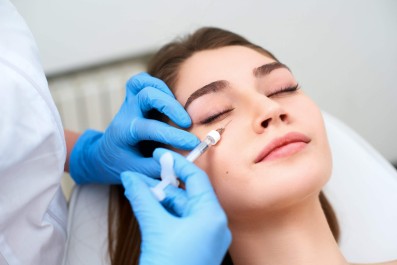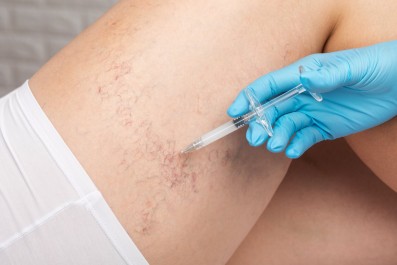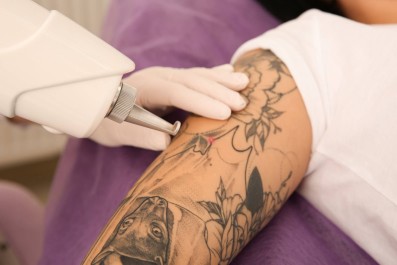Quest for Perfection by Louis Silberman
 Who doesn’t want to be beautiful? On the quest for perfection, consumers have always been more than willing to spend their hard-earned money on attaining flawless skin. In 2009 alone, Americans spent more than $10.5 billion on cosmetic procedures. Unfortunately, some of the most common skin concerns are the most difficult to treat.
Who doesn’t want to be beautiful? On the quest for perfection, consumers have always been more than willing to spend their hard-earned money on attaining flawless skin. In 2009 alone, Americans spent more than $10.5 billion on cosmetic procedures. Unfortunately, some of the most common skin concerns are the most difficult to treat.
Almost everyone can relate to the agony and embarrassment caused by the unsightly look of stretch marks, sagging skin and spider veins. A mix of frustration and hope has left everyone looking for the cure to these beauty burdens. With aesthetic clients reluctant to resort to surgical extremes or ineffective lotions and potions, it is easy to see why the high-tech medical aesthetic procedures performed in the modern day spa have quickly become the consumer’s number one skin secret.
The treatment of stretch marks, sagging skin, and spider veins used to bet the sole domain of plastic surgeons. However, thanks to recent advancements in cosmetic laser and radio frequency technologies, effective means to correct these conditions have moved out of the doctor’s office and into the spa.
According to the American Society for Aesthetic Plastic Surgery, there were more than 10 million cosmetic procedures performed last year, with non-surgical procedures making up more than 85% of the total. Since 1997, the total number of non-surgical procedures requested by consumers has increased by 231%. Based on these numbers, it is easy to see that the aesthetics profession is quickly evolving to incorporate safe solutions for skin concerns that were thought untreatable in the past. In the wake of this transition, a booming industry has formed, creating massive opportunities for those performing cosmetic laser treatments.
Attack of the Stretch Marks
A stretch mark, or stria, is a type of scarring that develops when skin stretches rapidly due to changes in the body. This action tears the dermis, breaking down collagen and greatly reducing skin elasticity, resulting in an uneven skin texture accompanied by lines of dark red or purple skin discoloration. The main culprits of this rapid stretching are the weight changes associated with pregnancy, weight lifting, diet and even the growth spurt occurring during puberty.
Stretch marks are a skin condition that affects men and women of all ages. Found on the arms, chest, stomach and thighs, they have the power to destroy self-confidence and body image. Next to acne, stretch marks are one of the most common naturally occurring skin concerns. Statistics show that 90% of pregnant woman, 70% of women and 40% of men have stretch marks somewhere on their body. Chances are that many of your clients fall into this demographic and have the desire to get rid of them.
In the past, people often turned to cocoa butter or pricey creams and salves in hopes that they would remove their stretch marks. Unfortunately, none of these methods effectively treats the root of the condition, the torn dermis. Going under the knife was also an option. While somewhat effective, this type of treatment is extremely expensive, involves a long and painful recovery period, as well as the possibility of creating new scars from the surgical incisions. Now, in 2010, the development of the Fractional Laser has given the public an effective new non-surgical treatment option for this skin condition. With the proper training, aesthetic professionals and spa owners now have the ability to offer a service that can laser away the marks.
Fractional Laser Skin Resurfacing works by splitting a laser beam into thousands of tiny microbeams. Using a special hand piece, cosmetic laser specialists project these microbeams into the epidermis and dermis. Each microbeam targets and coagulates a small fraction of the skin, leaving the surrounding tissue unharmed. Responding to the heat energy of the laser, the body begins to form new collagen and healthy tissue to replace the coagulated areas. This process not only repairs the skin’s texture, but also treats the discoloration present in the skin as well.
A fractional laser skin treatment typically lasts 30 to 60 minutes depending on the size of the treatment area. The average cost of the treatment can run from $800 to $1,200, with four to six visits needed to achieve maximum results. This treatment is quickly becoming a favorite among practitioners and beauty addicts alike. Clients love the visible results and aesthetic professionals like the revenue potential of up to $7,200 per client.
The Sagging Skin Solution
We have all heard the phrase “diamonds are forever.” Unfortunately, skin is not as resilient and inevitably begins to sag and wrinkle. Understanding why skin sags and how one can prevent or even reduce existing sagging can help you select the right treatment to meet the needs of your clients.
Skin constantly goes through a regenerative cycle. However, as we age, the skin’s natural elasticity begins to deteriorate. Over time, the regenerative process begins to decelerate as the underlying structure of the skin begins to break down, resulting in the loss of skin’s youthful appearance. While this happens naturally, there are also several other factors that determine when and how skin begins to show the signs of aging.
Not so surprisingly, the environment is one of the top causes of premature aging. Overexposure to the sun and the UV rays it projects harm collagen in the body. Collagen is the protein that holds the skin together and, when damaged, results in the loss of elasticity and firmness of the skin.
Genetics also plays a large role. While most aesthetic clients wish they were blessed with genes that would hold their skin together like Sharon Stone, few are so lucky. Some people age quicker than others regardless of the environment in which they live. Scary as it may seem, looking at one’s parents is the quickest glimpse into one’s aesthetic future. Chances are children will face the same problems as their parents when they are older.
Lifestyle habits are another major cause of why skin breaks down over time. Stress, alcohol and smoking all play factors in speeding up the skin’s biological clock. The higher the stress level, the more likely an individual is to frown, which can cause the collagen in the skin to break down and make dynamic wrinkles become permanent. Alcohol and smoking have the effect of drying and dehydrating the skin. This drains the natural moisture out of the skin, causing a reduction in its suppleness.
Although the clock is always ticking, there is still time to prevent and regenerate sagging skin. Did you know that radio waves are good for more than just playing music? Radio Frequency Skin Tightening, an exciting development in medical aesthetic treatment modalities, has become the top non-surgical choice for those seeking firmer skin as they age. Using a specialized hand piece that employs suction, the device generates radio frequency energy that creates heat in the dermis. This process causes the collagen in the treatment area to contract, in addition to stimulating the body’s healing process to produce additional collagen.
This treatment is effective on many areas of the body, including the face, neck, arms and stomach, leaving the client with smoother, tighter skin. Not only is this technique non-invasive, it is quick and easy to perform. Radio Frequency Skin Tightening has an average price of $300 to $500 per treatment. Clients will often see results after their first treatment, with maximum results appearing after four to six treatments.
The Tangled Web of Spider Vein
Aging gracefully is not as easy as it sounds. The older we get the faster time seems to fly. It is no wonder why it seems like some skin concerns pop up out of nowhere. Next to gray hair and wrinkles, one of the most common things people associate with looking old are spider veins. Spider veins are the tiny, unattractive bursts of deep purple or red that appears under the surface of the skin. They are typically found on the legs, nose, ankles, knees, and feet.
As time goes by, normal blood flow through veins and capillaries becomes compromised and circulation decreases. These blood vessels lose their elasticity and strength, just like the skin. As this happens, deoxygenated blood begins to collect and disperse into surrounding capillaries, causing spider veins to appear. While they are considered medically harmless, they still cause their fair share of grief. After all, nobody wants to be branded as having ‘grandma legs.’
So what should you do when your middle-aged clients come to you in a panic after waking up one morning to find one of these purple spider webs on the back of their leg? First, let them know that they are not alone. By the age of 50, more than 40% of women suffer from having superficial discolored veins on their bodies. After calming them down with a little aromatherapy, remind them that there is an effective treatment option you can provide that does not involve painful surgery or injections.
Laser Vein Reduction is a non-invasive procedure that any trained aesthetic professional can perform to eliminate the appearance of spider veins and broken capillaries. This treatment works by emitting a special wavelength of laser heat energy that is only absorbed by the specific red and purple colors of damage blood vessels. This heat seals off the vein from the body’s circulation, rendering it inactive. Over a short period of time, the color fades away as the body naturally dissipates the vein.
Laser Vein Reduction is FDA approved and has replaced surgery and injections as the preferred method to treat small spider veins and broken capillaries. Results from this procedure can be seen in as little as two to four treatments, depending on the size of the treatment area and severity of the discoloration. Most people report little to no pain, just a sensation of heating and tingling. There is no downtime required after the treatment and people receiving the procedure are free to go on with the rest of their day. Clients will love this results-oriented treatment and end up coming back for more. At an average cost of $200 to $400 and with so many people looking for a solution for their spider veins, offering this type of service can make a big impact on your earnings.
Training in Laser and Medical Aesthetics
The cosmetic laser marketplace continues to grow every year. The in-demand field of cosmetic lasers is changing the face of aesthetics as we know it and is a natural transition for aesthetic professionals wanting to offer more advanced services to their clients.
What many people may not realize is that they do not need to have a medical background to become a specialist in laser aesthetics. With the proper training, aesthetic professionals are able to expand into the medical aesthetics field with ease.
Requirements for certification in providing laser treatments vary from state to state. However, unlike the process of becoming a licensed esthetician, which can take months, the top comprehensive clinical and hands-on laser training programs in the country can be completed in two weeks or less.
When choosing a laser training school it is important to do the necessary research to make sure that you are receiving the highest level of education and training. This will help you create a safe environment for your clients, while providing the best quality treatments. Here is a sample list of questions to ask a prospective school:
Will I learn from a large variety of instructors?
Learning from more than one instructor provides a more well-rounded education. It is beneficial to hear a variety of different perspectives and industry experiences.
Do your instructors work as cosmetic laser technicians as well?
Instructors that actually work in the field in which they teach are better able to educate you on real-world situations and scenarios.
Does your training program include business development and marketing education to help me grow my business after graduation?
Learning to provide laser treatments is only the first step. Make sure the school you choose includes education on marketing, business development and how to grow you clientele after you leave school.
During my hands-on training, will I be able to work with a variety laser equipment?
Laser equipment is produced by a variety of manufacturers, each with their own unique interface and operation. Because different spa facilities use different equipment, it is important to learn to operate more than just one type of laser.
Will I get to train in an actual medical spa with real-world clients?
Working with actual clients in a spa setting will prepare you to handle the real-life situations you will experience in the workplace.
Bio
Louis “The Laser Guy” Silberman is president of National Laser Institute, a leading school specializing in advanced cosmetic laser training for aesthetic professionals. As an expert in laser aesthetics education and a nationally recognized author, Silberman has been a driving force behind creating the most advanced laser training programs in the country. To learn more about cosmetic laser education, call 800.982.6817 or simply fill out the form on your right.
|
|









